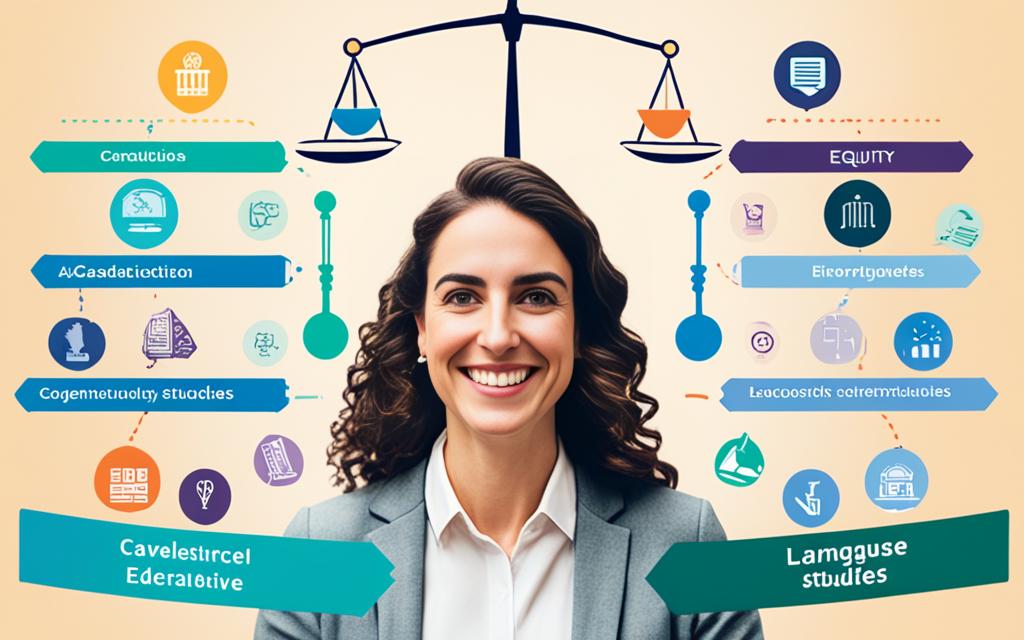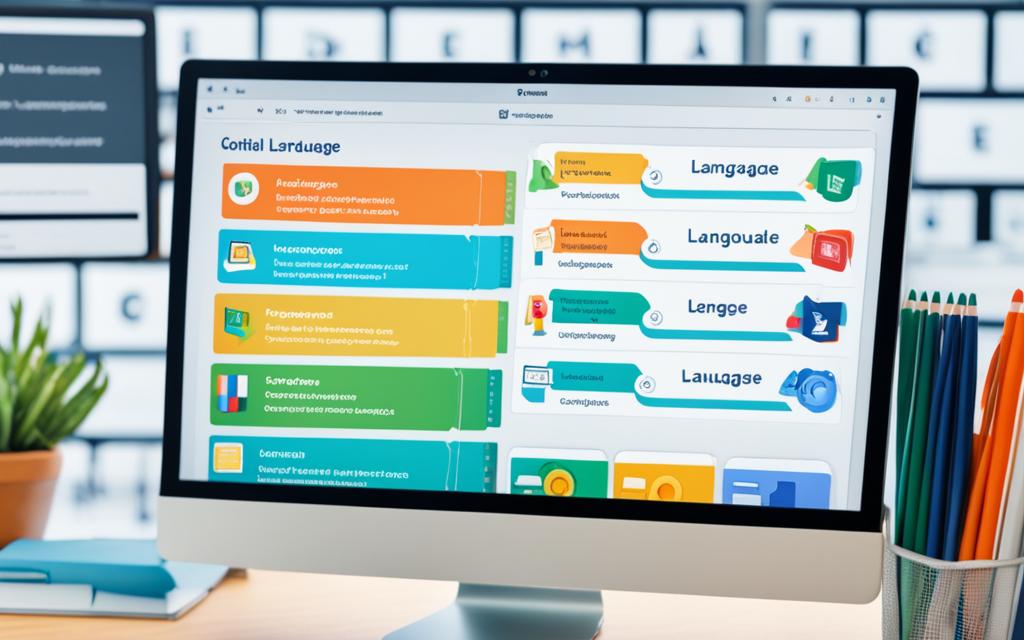Welcome to our comprehensive guide on navigating the world of language education. Whether you’re just starting out or aiming to become fluent, we’re here to help you map out your language learning journey and achieve your language proficiency goals. In this article, we’ll provide valuable insights, strategies, and resources to support you along the way.
Language education encompasses the process of language learning, acquisition, and the development of linguistic skills. Whether you’re interested in bilingualism, language immersion, or language study abroad, we’ll cover it all. By understanding the stages of the language education journey and setting achievable goals, you can make steady progress towards fluency.
Technology plays a significant role in language acquisition, and we’ll explore how incorporating instructional technology and digital language learning platforms can enhance your language skills. We’ll also discuss the advantages of language immersion programs and the benefits of experiential learning through language study abroad.
Proficiency milestones, such as those used to track English learner progress, are crucial for monitoring growth. We’ll provide insights on how to measure your language proficiency and offer recommendations on how to maintain and enhance your skills beyond your learning journey.
Lastly, we’ll highlight a range of language education resources, including online platforms, textbooks, and language exchange programs. These resources will support your language learning efforts and further enable you to achieve your desired level of proficiency.
Embark on your language education journey with us and discover the path to fluency. Let’s get started!
Key Takeaways:
- Maintain a clear understanding of the different stages of the language education journey.
- Set achievable goals that align with your current language proficiency level.
- Embrace technology to enhance your language learning experience and linguistic development.
- Consider the advantages of language immersion programs and experiential learning abroad.
- Monitor your language proficiency milestones and track your progress using relevant tools and dashboards.
Understanding the Language Education Journey
In this section, we will explore the different stages of the language education journey. From the initial steps of learning a new language to achieving fluency, understanding the process will allow you to set realistic goals and track your progress. We will discuss the challenges and milestones you can expect to encounter along the way.
Setting Achievable Goals: Novice to Proficient
In language education, setting achievable goals is the key to success. As you embark on your language learning journey, it’s important to establish goals that align with your current language proficiency level. This section will guide you through the process of setting realistic and attainable goals, helping you stay motivated and track your progress along the way.
When setting language learning goals, consider the following:
- Assess your current language proficiency level: Before setting goals, it’s crucial to evaluate your current language skills. This self-assessment will help you determine your starting point and identify areas for improvement.
- Identify specific language learning objectives: Clearly define what you want to achieve in your language education journey. Whether it’s improving your speaking skills, expanding your vocabulary, or mastering grammar, setting specific objectives will give you a clear focus.
- Break down long-term goals into smaller milestones: Instead of solely focusing on the end result, divide your goals into smaller, manageable milestones. This approach allows you to celebrate small wins along the way, keeping you motivated and engaged.
- Set measurable goals: It’s crucial to establish goals that can be measured. For example, instead of setting a vague goal like “improve speaking skills,” set a measurable goal like “hold a conversation for 10 minutes without relying on translation.”
- Establish a timeline: Determine a realistic timeline for achieving your goals. Assign deadlines to your milestones to ensure progress and maintain accountability.
Remember, setting achievable goals is a balancing act. While it’s essential to challenge yourself, it’s equally important to set goals that are realistic and attainable. By finding the right balance, you can stay motivated and make steady progress in your language learning journey.
To measure your language learning progress, consider implementing the following techniques:
- Regular self-assessment: Conduct periodic self-assessments to evaluate your language skills. Use a proficiency scale or language assessment tools to objectively measure your progress.
- Track your vocabulary expansion: Keep a vocabulary journal and record new words as you learn them. Regularly review and test yourself on the words to reinforce your memory and monitor your vocabulary growth.
- Engage in conversation practice: Actively engage in conversations with native speakers or language partners. Regularly challenging yourself to communicate in the target language allows you to gauge your speaking and listening skills.
- Take language proficiency tests: Consider taking standardized language proficiency tests, such as the TOEFL or the CEFR exams. These tests provide an accurate assessment of your language skills and can serve as a benchmark for your progress.

By setting achievable goals and implementing effective measurement techniques, you can track your language learning progress and make continuous strides towards proficiency. Remember, consistency and dedication are key factors in achieving your language learning goals.
The Role of Academic Institutions in Language Learning
Academic institutions play a crucial role in language education. They provide the foundation for students to develop language proficiency, cultural understanding, and global perspectives. Through language programs offered by these institutions, students gain the necessary skills to communicate effectively in different languages and navigate cross-cultural contexts.
Excellence in Language Programs: Insights from CVESD
When it comes to language education, excellence in language programs is key. The Chula Vista Elementary School District (CVESD) serves as a distinguished example of a district that excels in providing quality language education. With a commitment to bilingual education and a focus on equity, CVESD has implemented innovative language programs that promote linguistic development and cultural competence.

Choosing the Right Language Education Programs
When choosing a language education program, it is important to consider several factors. Evaluate the program’s curriculum, teaching methods, and resources to ensure they align with your language learning goals. Additionally, consider the opportunities for cultural immersion and real-world application of language skills. This will aid in selecting a program that best suits your needs and enhances your language acquisition journey.
Equity and Social-Emotional Wellness in Language Studies
In recent years, there has been a growing emphasis on equity and social-emotional wellness in language studies. It is vital for academic institutions to create an inclusive and supportive environment that values all students’ cultural backgrounds and fosters their social-emotional well-being. By prioritizing equity and social-emotional wellness, language education programs can promote a holistic approach to language learning that benefits learners both academically and personally.
Embracing Technology in your Language Acquisition
Technology has revolutionized language acquisition, providing learners with innovative tools and platforms to enhance their language learning experience. In this section, we will explore how you can leverage technology to accelerate your linguistic development and achieve your language learning goals.
Integrating AWS Training for Linguistic Development

One powerful technology that can significantly impact your language acquisition is AWS (Amazon Web Services) training. AWS offers a wide range of language processing and analysis tools that can enhance your linguistic development. By immersing yourself in AWS training, you can gain valuable skills and insights into natural language understanding, machine translation, and speech recognition.
Through practical hands-on exercises and real-world applications, AWS training enables you to develop a deeper understanding of language usage, structure, and semantics. This knowledge can be applied to various language learning tasks, such as improving pronunciation and accent, understanding grammar rules, and expanding vocabulary.
Benefits of Digital Language Learning Platforms
Digital language learning platforms have emerged as valuable resources for learners of all levels. These platforms offer interactive and personalized learning experiences that cater to individual needs and preferences.
One of the key benefits of digital language learning platforms is their adaptability. They can provide customized content and adapt the learning path based on your strengths, weaknesses, and progress. This personalized approach ensures that you focus on areas that require improvement, making your language acquisition journey more efficient and effective.
Additionally, digital language learning platforms often incorporate gamified elements, which can make the learning process more engaging and enjoyable. Through interactive exercises, quizzes, and rewards, these platforms create a dynamic learning environment that motivates learners to continue their language studies.
Moreover, these platforms often offer social features that allow you to connect with fellow language learners from around the world. Engaging in conversations, exchanging ideas, and receiving feedback from peers can enhance your language skills and provide cultural insights.
By embracing technology and utilizing AWS training and digital language learning platforms, you can unlock new possibilities for linguistic development and accelerate your language acquisition journey.
Language Skills Development Through Instructional Technology
Instructional technology plays a pivotal role in language skills development. By integrating technology into language learning, learners can enhance their proficiency and improve their overall language acquisition experience.
One of the key advantages of instructional technology is its ability to provide interactive and engaging learning environments. Through multimedia resources, language learners can engage with authentic materials such as videos, audio recordings, and interactive exercises. This exposure to real-world language usage helps learners develop listening, speaking, reading, and writing skills in a more dynamic and immersive way.
Technology also offers personalized learning experiences tailored to individual needs and preferences. Language learning platforms and apps often utilize artificial intelligence algorithms to analyze learners’ strengths and weaknesses, providing them with targeted exercises and feedback. This personalized approach allows learners to focus on specific areas of language development to accelerate their progress.
“The integration of instructional technology in language education has proven to be a powerful tool for language skills development. It provides learners with engaging and personalized learning experiences, which is crucial for effective language acquisition.” – Language Education Expert
Furthermore, instructional technology facilitates collaborative learning opportunities. Online forums, discussion boards, and virtual classrooms enable learners to interact with peers and native speakers, fostering language practice and cultural understanding. These collaborative experiences not only enhance language skills but also promote cultural awareness and global perspectives.
Another notable benefit of instructional technology is its flexibility and accessibility. Language learners can access learning materials and resources anytime and anywhere, allowing for self-paced and independent learning. This flexibility accommodates learners’ busy schedules and different learning styles, promoting autonomy and self-directed language learning.
Overall, instructional technology offers innovative tools and resources that significantly contribute to language skills development. By embracing technology in language education, learners can enhance their proficiency, broaden their cultural knowledge, and ultimately achieve their language learning goals.

Advantages of Language Immersion Programs
Language immersion programs provide a unique and immersive approach to language learning. By surrounding yourself with native speakers and immersing yourself in the target language and culture, you can accelerate your language acquisition and proficiency. Whether you are a beginner or advanced learner, language immersion programs offer numerous advantages that can enhance your language education journey.
Here are some key advantages of language immersion programs:
- Enhanced Language Skills: Language immersion programs provide continuous exposure to the target language, allowing you to practice and improve your listening, speaking, reading, and writing skills. Regular interactions with native speakers facilitate a deeper understanding of the language and its cultural nuances.
- Cultural Immersion: Immerse yourself in the culture of the target language by participating in language immersion programs. Engaging with local customs, traditions, and daily life experiences not only enhances language learning but also promotes cultural awareness and understanding.
- Increased Confidence: Language immersion programs provide a supportive environment for language learners to practice and gain confidence in using the target language. Through real-life interactions and practical language usage, you can develop fluency and overcome the fear of making mistakes.
- Authentic Context: One of the main advantages of language immersion programs is the exposure to authentic language usage. By being surrounded by native speakers, you can learn the language as it is naturally spoken, including colloquial expressions, idioms, and cultural references.
- Accelerated Learning: The immersive nature of language immersion programs can significantly accelerate the language learning process. Through constant exposure and intensive practice, learners can make rapid progress in acquiring vocabulary, grammar, and language structures.
To illustrate the benefits of language immersion programs, take a look at the following table:
| Advantage | Description |
|---|---|
| Enhanced Language Skills | Continuous exposure to the target language improves listening, speaking, reading, and writing skills. |
| Cultural Immersion | Engaging with local customs and traditions promotes cultural awareness and understanding. |
| Increased Confidence | Real-life interactions in the target language boost confidence and fluency. |
| Authentic Context | Surrounding oneself with native speakers exposes learners to authentic language usage. |
| Accelerated Learning | Intensive practice and constant exposure accelerate language acquisition. |
As demonstrated, language immersion programs offer valuable advantages that can greatly enhance your language learning experience. Whether you choose a short-term program or an extended study abroad opportunity, the immersive environment can propel you towards language proficiency and cultural enrichment.
Plotting Progress: Language Proficiency Milestones
Measuring language proficiency is a crucial aspect of your language education journey. It allows you to monitor your growth, set achievable goals, and track your progress over time. By identifying language proficiency milestones, you can gain a deeper understanding of your strengths and areas for improvement. These milestones serve as important benchmarks that indicate your progress towards fluency.
Language proficiency milestones are typically defined on a scale that ranges from beginner to advanced levels. Commonly used scales include the Common European Framework of Reference for Languages (CEFR) and the Interagency Language Roundtable (ILR) scale. These scales provide a standardized framework for assessing language skills, with specific criteria for each proficiency level.
When monitoring your language learning progress, it’s essential to be aware of these milestones and what they represent. By regularly assessing your skills and comparing them to the relevant proficiency level, you can determine your current position on the language proficiency scale.
Tracking your English learner progress involves a systematic approach to monitoring your growth. This can be done through various methods, such as:
- Self-assessment: Reflecting on your language skills and identifying areas of improvement.
- Formal assessments: Taking standardized language tests to measure your proficiency.
- Feedback from teachers or language partners: Seeking input from others who can evaluate your language skills objectively.
- Monitoring language tasks and assignments: Keeping track of your performance in language learning activities and assignments.
- Language immersion experiences: Assessing your ability to communicate effectively in real-life situations.
To facilitate the tracking of English learner progress, the use of dashboards has become increasingly popular. These digital tools provide an interactive interface that allows learners to visualize their growth, track their achievements, and set goals for further improvement. Dashboards often include features such as progress charts, personalized recommendations, and performance analytics.
Effective monitoring of language learning progress and tracking English learner progress can help you stay motivated, identify areas for improvement, and celebrate your achievements along the way. By understanding language proficiency milestones and utilizing tools such as dashboards, you can make informed decisions about your language education journey and progress towards your goal of becoming fluent.
Experiential Learning: Language Study Abroad
Language study abroad programs provide a unique opportunity for experiential learning, allowing you to immerse yourself in a new language and culture. This section will explore the benefits of studying abroad in enhancing your language acquisition skills and deepening your understanding of the target language.
Language study abroad programs offer a rich and immersive environment where you can practice your language skills in real-life situations. By living and studying in a foreign country, you will be exposed to authentic language use, improving your listening and speaking abilities. Engaging with native speakers on a daily basis allows for natural language acquisition and the development of cultural competency.
Furthermore, studying abroad provides opportunities for cultural immersion, expanding your global perspective and deepening your understanding of the target language. You will have the chance to experience the customs, traditions, and history of the country firsthand, enriching your language education with real-world context.
“Studying abroad is an invaluable experience for language learners. It provides a unique opportunity to step out of your comfort zone and fully immerse yourself in a foreign language and culture.”
Moreover, language study abroad programs foster personal growth and independence. Navigating daily life in a foreign country challenges you to adapt to new circumstances, develop problem-solving skills, and become more self-reliant. These experiences contribute to your overall language learning journey and enhance your ability to communicate effectively in diverse situations.
In summary, language study abroad programs offer a transformative and enriching experience, allowing you to learn a language in an immersive and authentic environment. The combination of language acquisition, cultural immersion, and personal growth makes studying abroad an invaluable component of language education.
Strategies for Language Acquisition and Bilingualism
Language acquisition and bilingualism are complex processes that require effective strategies. In this section, we will explore various strategies that can help you enhance your language learning journey and foster bilingualism. By implementing these strategies, you can accelerate your language acquisition and develop proficiency in multiple languages.
The Impact of Bilingual Education in Schools
Bilingual education plays a crucial role in promoting language development and cultural awareness among students. By providing instruction in two or more languages, bilingual education facilitates language acquisition and fosters a deeper understanding of different cultures. Research has shown that bilingual education programs not only improve language skills but also enhance cognitive abilities, academic performance, and social-emotional well-being. Such programs create a supportive and inclusive learning environment where students can thrive academically and linguistically.
Innovative Language Teaching Practices
Innovative language teaching practices can significantly enhance language learning outcomes. Educators around the world are implementing creative approaches to engage students and facilitate language acquisition. From technology integration to project-based learning and immersive experiences, these practices provide students with interactive and dynamic learning opportunities. Innovative language teaching practices promote active participation, critical thinking, and real-world application of language skills. By embracing these practices, educators can create a stimulating learning environment that cultivates linguistic development and cultural competence.
| Language Acquisition Strategies | Bilingualism Benefits |
|---|---|
| 1. Immersion programs | 1. Improved cognitive abilities |
| 2. Language exchange programs | 2. Enhanced academic performance |
| 3. Multimedia resources | 3. Increased cultural awareness |
| 4. Conversation practice | 4. Expanded career opportunities |
| 5. Contextual learning | 5. Enhanced problem-solving skills |
Bridging the Gap: Language Education Resources
Language education resources are essential tools for supporting language learning and enhancing proficiency. In this section, we will explore a range of resources that can help language learners on their journey to fluency.
Online platforms offer a wealth of resources for language learners of all levels. These platforms provide access to interactive lessons, vocabulary exercises, grammar drills, and language practice with native speakers. Utilizing these online resources can supplement your language learning efforts and provide opportunities for immersive language practice.
Textbooks also serve as valuable resources for language education. They offer structured lessons, explanations of grammar rules, vocabulary lists, and exercises to reinforce language skills. Textbooks provide a comprehensive and systematic approach to language learning, allowing learners to progress at their own pace.
Language exchange programs provide a unique opportunity to practice language skills in a real-life context. By connecting with native speakers, learners can engage in language exchanges, where they can practice conversation skills and gain cultural insights. Language exchange programs foster language immersion and offer a dynamic learning experience.
Language learning apps are another valuable resource in language education. These apps provide flexibility and convenience, allowing learners to practice language skills anytime and anywhere. They often include features such as flashcards, quizzes, and audio exercises, enhancing language proficiency through interactive and engaging activities.
By integrating a variety of resources into your language learning routine, you can create a well-rounded and effective learning experience. Experiment with different platforms, textbooks, exchange programs, and apps to find the resources that best suit your individual learning style and goals.
Remember, consistency and dedication are key to language learning success. Take advantage of the abundant language education resources available to you and make the most of your language learning journey.
Conclusion
In conclusion, mapping your language education journey is a crucial step towards achieving fluency. Throughout this article, we have explored the different stages of the language education journey, from novice to proficient. By understanding the process and setting achievable goals, you can track your progress and stay motivated.
Academic institutions play a significant role in language education, and it is important to choose the right language education program that aligns with your goals. Additionally, technology has revolutionized language acquisition, offering innovative tools and platforms to enhance your learning experience.
Maintaining and enhancing language proficiency requires a commitment beyond this article. By embracing experiential learning, such as language study abroad programs, and implementing effective strategies, you can continue to develop your language skills. Moreover, utilizing language education resources, such as online platforms and language exchange programs, can further support your learning journey.
Remember, your language education journey is a lifelong process. By setting goals, tracking your progress, and utilizing available resources, you can navigate the path from novice to fluent. Maintain your motivation, stay consistent, and immerse yourself in the language to reach your ultimate language learning goals.
FAQ
What is the purpose of this comprehensive guide?
The purpose of this guide is to provide valuable insights, strategies, and resources to help you navigate the world of language education and achieve your language learning goals.
What will I learn from this guide?
In this guide, you will learn about the different stages of the language education journey, how to set achievable goals, the role of academic institutions in language learning, the integration of technology in language acquisition, language immersion programs, measuring language proficiency, language study abroad programs, strategies for language acquisition and bilingualism, and the range of language education resources available.
How can I map my language education journey?
Mapping your language education journey involves understanding the different stages from being a novice to becoming fluent in a language. This guide will provide you with insights on how to set goals, track your progress, and overcome challenges along the way.
What types of goals should I set for language learning?
The guide will provide practical tips and techniques for setting goals that align with your language proficiency level. It will help you measure your progress and stay motivated throughout your language learning journey.
How do academic institutions contribute to language education?
Academic institutions play a crucial role in language education by offering excellent language programs. The guide will explore the significance of excellence in language programs and provide insights from the Chula Vista Elementary School District (CVESD) as a case study. It will also discuss factors to consider when choosing the right language education program and the importance of equity and social-emotional wellness in language studies.
What is the role of technology in language acquisition?
Technology has revolutionized language acquisition. The guide will explore how you can leverage technology to enhance your language learning experience. It will discuss the integration of AWS training for linguistic development and the benefits of digital language learning platforms.
How can instructional technology enhance language skills development?
The guide will explore the role of instructional technology in enhancing language skills development. It will discuss how instructional technology can be used to facilitate the acquisition of key language skills.
What are the advantages of language immersion programs?
Language immersion programs offer a unique and immersive approach to language learning. The guide will discuss the advantages of language immersion programs and how they can accelerate language acquisition and proficiency.
How can I measure my language proficiency?
Measuring language proficiency is essential for monitoring progress and setting benchmarks. The guide will explore language proficiency milestones and techniques for tracking your growth throughout your language education journey. It will also examine the use of dashboards to track English learner progress.
What are the benefits of language study abroad programs?
Language study abroad programs offer a unique and immersive language learning experience. The guide will discuss the benefits of experiential learning through language study abroad and how it can enhance your language acquisition skills.
Which strategies can enhance language acquisition and bilingualism?
The guide will explore various strategies for language acquisition and the impact of bilingual education in schools. It will also discuss innovative language teaching practices that can enhance language learning outcomes.
What language education resources are available?
Language education resources play a vital role in supporting language learning. The guide will explore a range of resources available to language learners, including online platforms, textbooks, language exchange programs, and more. It will provide recommendations and tips on how to make the most of these resources.
Source Links
- https://www.cvesd.org/news/what’s–new/2022-23_california_school_dashboard_ratings
- https://aws.amazon.com/training/digital/aws-digital-classroom/
- https://nusd.org/nusd-welcomes-new-director/

